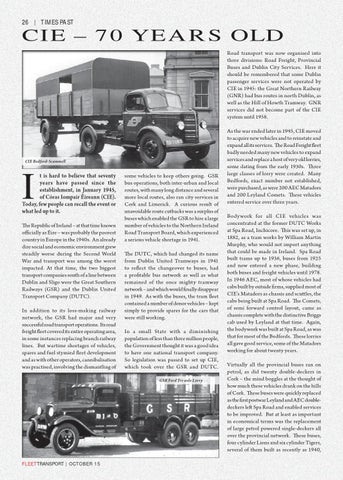26 | TIMES PAST
CIE – 70 YEARS OLD Road transport was now organised into three divisions: Road Freight, Provincial Buses and Dublin City Services. Here it should be remembered that some Dublin passenger services were not operated by CIE in 1945: the Great Northern Railway (GNR) had bus routes in north Dublin, as well as the Hill of Howth Tramway. GNR services did not become part of the CIE system until 1958.
CIE Bedford-Scammell
I
t is hard to believe that seventy years have passed since the establishment, in January 1945, of Córas Iompair Éireann (CIE). Today, few people can recall the event or what led up to it. The Republic of Ireland – at that time known officially as Éire – was probably the poorest country in Europe in the 1940s. An already dire social and economic environment grew steadily worse during the Second World War and transport was among the worst impacted. At that time, the two biggest transport companies south of a line between Dublin and Sligo were the Great Southern Railways (GSR) and the Dublin United Transport Company (DUTC). In addition to its loss-making railway network, the GSR had major and very successful road transport operations. Its road freight fleet covered its entire operating area, in some instances replacing branch railway lines. But wartime shortages of vehicles, spares and fuel stymied fleet development and as with other operators, cannibalisation was practised, involving the dismantling of
some vehicles to keep others going. GSR bus operations, both inter-urban and local routes, with many long distance and several more local routes, also ran city services in Cork and Limerick. A curious result of unavoidable route cutbacks was a surplus of buses which enabled the GSR to hire a large number of vehicles to the Northern Ireland Road Transport Board, which experienced a serious vehicle shortage in 1941. The DUTC, which had changed its name from Dublin United Tramways in 1941 to reflect the changeover to buses, had a profitable bus network as well as what remained of the once mighty tramway network – and which would finally disappear in 1949. As with the buses, the tram fleet contained a number of donor vehicles – kept simply to provide spares for the cars that were still working. In a small State with a diminishing population of less than three million people, the Government thought it was a good idea to have one national transport company. So legislation was passed to set up CIE, which took over the GSR and DUTC. GSR Ford Tri-axle Lorry
FLEETTRANSPORT | OCTOBER 15
As the war ended later in 1945, CIE moved to acquire new vehicles and to reinstate and expand all its services. The Road Freight fleet badly needed many new vehicles to expand services and replace a host of very old lorries, some dating from the early 1930s. Th ree large classes of lorry were created. Many Bedfords, exact number not established, were purchased, as were 200 AEC Matadors and 200 Leyland Comets. These vehicles entered service over three years. Bodywork for all CIE vehicles was concentrated at the former DUTC Works at Spa Road, Inchicore. Th is was set up, in 1882, as a tram works by William Martin Murphy, who would not import anything that could be made in Ireland. Spa Road built trams up to 1936, buses from 1925 and now entered a new phase, building both buses and freight vehicles until 1978. In 1946 AEC, most of whose vehicles had cabs built by outside fi rms, supplied most of CIE’s Matadors as chassis and scutt les, the cabs being built at Spa Road. The Comets, of semi forward control layout, came as chassis complete with the distinctive Briggs cab used by Leyland at that time. Again, the bodywork was built at Spa Road, as was that for most of the Bedfords. These lorries all gave good service, some of the Matadors working for about twenty years. Virtually all the provincial buses ran on petrol, as did twenty double-deckers in Cork – the mind boggles at the thought of how much these vehicles drank on the hills of Cork. These buses were quickly replaced as the first postwar Leyland and AEC doubledeckers left Spa Road and enabled services to be improved. But at least as important in economical terms was the replacement of large petrol powered single-deckers all over the provincial network. These buses, four cylinder Lions and six cylinder Tigers, several of them built as recently as 1940,
